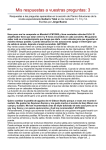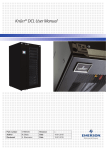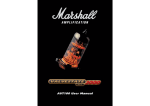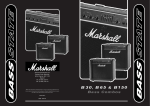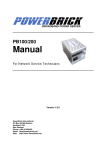Download Marshall Amplification DRP-1 User's Manual
Transcript
DRP-1 Direct Recording Pre-Amp ENGLISH FROM THE CHAIRMAN I would like to thank you personally for selecting one of our Direct Recording Pre-amps. In our quest to make the sound of Marshall more accessible, we constantly use the knowledge and experience of our Research and Development team to produce new products. Following the success of the SE100 Speaker Emulator and PB100 Power brake, we have now produced the DRP-1 Direct Recording Pre-Amp. A remarkable and compact device which is incredibly versatile and which offers a true simulation of a Marshall Stack for either recording or practice purposes, plus pre-amp facilities if you wish to extend your existing amp/ combo or drive a power amp and cabinet set-up. The full experience of the same design team that produced the JCM 900, Anniversary and Valvestate ranges has been brought to bear on the DRP-1. This ensures that the sound quality, engineering and construction are everything you would expect from a product bearing the Marshall logo. I wish you every success and above all, hope you enjoy using your Direct Recording Pre-amp. Sincerely, 2 ENGLISH WARNING! PLEASE READ THE FOLLOWING LIST CAREFULLY A. DO NOT attempt to remove the DRP-1 chassis. There are no user serviceable parts inside. B. ALWAYS have this equipment serviced or repaired by competent, qualified personnel. C. PLEASE READ this instruction manual carefully before switching on. DRP-1 Direct Recording Pre-amp. The Marshall Direct Recording Pre-Amp is in essence a complete Marshall stack in miniature, despite it’s compact size the DRP-1 uses micro electronic techniques to emulate the tone and feel of a typical Marshall pre-amp, power amp and loudspeaker cabinet. This allows the recording and reproducing of great guitar sounds with the minimum of fuss and without the need to set-up and mic your normal guitar amp rig. The benefits of the DRP-1 can be utilised beyond the realms of the home studio. For instance the built-in stereo headphone amplifier can be coupled to your favourite effects processor to give your personal practice routines the realism of your stage sound. Alternatively, use the DRP-1 plugged into the front end of your normal guitar amp to fully ‘Marshallize’ it. Another use of the DRP-1 is to go direct into the PA from the emulated line-out. This is especially handy for rehearsal, where instead of transporting your main system along, you can turn up with the DRP-1 and just plug in and play. In addition to the guitar uses, the Direct Recording Pre-Amp can be used to add warmth and another dimension to keyboards, especially when mixed with the original sound. 3 Front Panel. 1. Pre-Amp Volume. Controls the level of input gain. Lower levels will produce cleaner sounds, whilst higher settings will increase the distortion produced by the preamp circuitry. The boost switch (Item 7) provides two basic gain levels comparable to classic and contemporary Marshall amps. 2. Master Volume. As in a true guitar amplifier the master volume regulates the amount of signal passed from the ‘pre-amp’ into the ‘power amp’ section. The amount of drive passed through to the power amp will influence the tone and overdrive capabilities of the entire unit. 3,4 & 5. Bass, Middle & Treble controls. The Middle and Treble controls are based on the passive system found on most Marshall amps, but have a wider sweep allowing you to re-create many types of guitar amp sounds. The active Bass control is designed not only to interact with the Treble and Middle controls, but also to emulate the resonant low end ‘Thump’ associated with a Marshall 4x12 cabinet. 6. Line Level. Controls the output level from the Pre-Amp Out jack (Pre Speaker Emulation), from the Speaker Emulated Line Out jack and from the Headphone Amp. 7. Boost/ Battery level switch. Multi purpose switch that selects the two gain parameters of the pre-amp and also a ‘momentary’ position to test the battery level in conjunction with LED (Item 8). When activated by the switch (Item 7) the LED will illuminate when there is sufficient battery power to run the DRP-1. passed onto other externally connected equipment, any channel faders etc. should be down when inserting the headphone jack. Note! Low battery levels will produce no light from the LED, whilst borderline power will produce only a dim output. Due to the widely varying nature of headphones, undesired clipping of the headphone amplifier may occur and will produce harsh distortion. Rear Panel. To control this simply reduce the line level until a satisfactory tone is achieved. 9. Input Jack. Accepts the input from the guitar. 10. D.C. Input. Accepts 9V DC power from a regulated power supply. 11. Pre-amp Out jack. A buffered output suitable for feeding a ‘live’ guitar system such as a separate power amp and guitar speaker cabinet set-up. 12. Line Out Jack. Provides the output from the ‘power amp/ loud speaker emulator’.This output should be used when wanting to directly record a full guitar amp simulation. The Line Out socket would also be used to feed the input of your effects processor when using the DRP-1 for private practice through the headphone amplifier, or to feed the input of a normal guitar amp/ combo as an additional preamp. 15. Battery Compartment (Located in the base of the unit). Finger removable cover gives easy access to the battery compartment for the 9V PP3 or equivalent type battery. Note! The power to the DRP-1 is controlled by the guitar input jack, therefore to preserve the battery life the guitar lead should be removed when the unit is not in use. 13. Headphone Amp Input Jack. Using an external power supply will switch out the battery, but the DRP-1 is still turned on/off by the guitar input jack. A stereo jack accessing the input to the headphone amplifier which allows the insertion of effects processors between the headphone amp and the output of the emulator. When unplugging the input jack, it is a wise precaution to turn down any mixer or recorder level controls to prevent any handling noise being passed onto external equipment. By connecting the left and the right outputs of the processor to this socket using a stereo jack to two mono jack Y lead, you can gain all the benefits of your favourite effects through the stereo headphones connected to socket 14. 14. Headphone Amp Output Jack. A stereo 3.5 mm jack fed from the integrated headphone amp, which will suit stereo headphones from 32 to 600 Ohm impedance, for private practice. To maximise the life of the battery, the headphone amp is only provided with power when the headphones are fully connected to the socket. To prevent the switching transient being 4 ENGLISH 8. Battery Level LED. ENGLISH Some Suggested Set-ups Headphone/ practice amp. Remember that pedal type effects can be added between the guitar and input of the DRP-1 as you would with a normal guitar amp. ● When recording it is recommended that effects are added at the mix stage as is usually the case when recording a standard guitar amp. ● Live sound pre-amp. FEATURE GUIDE FX IN Stereo input to take the left and right returns from your effects processor (using a stereo jack to 2x mono jack Y lead) when using the DRP-1 as a headphone practice amp only. FX OUT Filtered Line Out socket to feed the input of your effects processor when using the DRP-1 as a headphone practice amp and controlled by the Line Out level control. Recording emulator or live P.A. HEADPHONES Output for the connection of stereo headphones for private practice sessions. I M X MIXER Filtered Line Out featuring Marshall emulation for direct connection to either P.A. or recording mixers (May also be used to drive the input of a normal guitar combo). POWER AMP Direct pre-amp output to drive a power amp and cabinet set up. Also provides an unfiltered alternative output for direct recording purposes -ideal for recording bright ‘glassy’ clean sounds. I M GUITAR Input jack for the connection from the guitar. 5 X GUITAR INPUT JACK INPUT AMP PREAMP VOL. GAIN AMP TONE DRIVER PASSIVE TONE MASTER VOL. PREAMP OUT BUFFER PREAMP OUT JACK @@@@@@@@e? @@@@@@@@e?@@@@@@@@?e@@@@@@@@e?@@@@@@@@?e@@@@@@@@e?@@@@@@@@?e@@@@@@@@e?@@@@@@@@?e@@@@@@@@e?@@@@@@@@?e@@@@@@@@e?@@@@@@@@?e @@@@@@@@e? @@@@@@@@e?@@@@@@@@?e@@@@@@@@e?@@@@@@@@?e@@@@@@@@e?@@@@@@@@?e@@@@@@@@e?@@@@@@@@?e@@@@@@@@e?@@@@@@@@?e@@@@@@@@e?@@@@@@@@?e@@@@@@@@ @@@@@@@@ @@h? @@ @@h? @@ @@h? @@ @@h? @@ @@h? @@ @@h? @@ @@ @@ @@ @@ @@ @@ @@ @@ @@ @@ @@ @@ @@ @@ @@ @@ @@ @@ @@ @@ @@ @@ @@ @@ @@ @@ @@ @@ @@ @@ @@ @@ @@ @@ @@ @@ @@ @@ @@ @@ @@ @@ @@ @@ @@ @@ @@ @@ @@ @@ @@ @@ @@ @@ @@ @@ @@ @@ @@ @@ @@ @@ @@ @@ @@ @@ @@ @@ @@ @@ @@ @@ @@ @@ @@ @@ @@ @@ @@ @@ @@g @@g @@g @@g @@g @@g @@@@@@@@ @@@@@@@@ ?@@@@@@@@?e@@@@@@@@e?@@@@@@@@?e@@@@@@@@e?@@@@@@@@?e@@@@@@@@e?@@@@@@@@?e@@@@@@@@e?@@@@@@@@?e@@@@@@@@e?@@@@@@@@?e@@@@@@@@ ?@@@@@@@@?e@@@@@@@@e?@@@@@@@@?e@@@@@@@@e?@@@@@@@@?e@@@@@@@@e?@@@@@@@@?e@@@@@@@@e?@@@@@@@@?e@@@@@@@@e?@@@@@@@@?e@@@@@@@@ ?@@ ?@@ ?@@ ?@@ ?@@ ?@@ ?@@@@@@@@ ?@@@@@@@@ BASS MID. TREBLE. ON POWER SWITCH Master Volume . . . Bass Middle Treble Line Level Battery Test Gain . HEADPHONE AMP INPUT JACK HEADPHONE AMP 1. 2. HEADPHONE AMP INPUT JACK @@@@@@@@e? @@@@@@@@e?@@@@@@@@?e@@@@@@@@e?@@@@@@@@?e @@@@@@@@e? @@@@@@@@e?@@@@@@@@?e@@@@@@@@e?@@@@@@@@?e@@@@@@@@ @@@@@@@@ @@h? @@ @@h? @@ @@h? @@ @@h? @@ @@h? @@ @@h? @@ . . . . . . . . ▲ ▲ Rear Panel. LINE LEVEL 8. Boost Normal Preamp Volume POWER LOUDSPEAKER AMP CABINET SIMULATOR SIMULATOR BATTERY TEST L.E.D. BOOST SWITCH 7. Front Panel. OFF 3. 4. 5. 6. Headphone Out Headphone In Line Out Pre-amp Out DC Input Input 14. 13. 12. 11. 10. 9. 6 @@ @@ @@ @@ @@ @@ @@ @@ @@ @@ @@ @@ @@ @@ @@ @@ @@ @@ @@ @@ @@ @@ @@ @@ @@ @@ @@ @@ @@ @@ @@ @@ @@ @@ @@ @@ @@ @@ @@ @@ @@ @@ @@ @@ @@ @@ @@ @@ @@ @@ @@ @@ @@ @@ @@ @@ @@ @@ @@ @@ @@ @@ @@ @@ @@ @@ @@ @@ @@ @@ @@ @@ @@ @@ @@ @@ @@ @@ @@ @@ @@ @@ @@ @@ @@ @@ @@ @@ @@ @@ @@ @@ @@ @@ @@ @@ @@ @@ @@ @@ @@ @@ @@ @@ @@ @@ @@ @@ @@ @@ @@ @@ @@g ?@@ @@g ?@@ @@g ?@@ @@g ?@@ @@g ?@@ @@g ?@@ @@@@@@@@ ?@@@@@@@@ @@@@@@@@ ?@@@@@@@@?e@@@@@@@@e?@@@@@@@@?e@@@@@@@@ ?@@@@@@@@?e@@@@@@@@e?@@@@@@@@?e@@@@@@@@ ?@@@@@@@@ +9v 7 LINE OUT JACK






